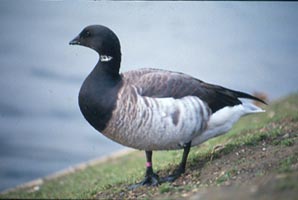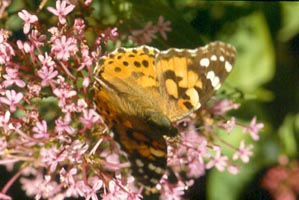Tree
Week Walks on Dalkey & Killiney Hill
As part of National Tree Week DLRCC had organised three walks on Killiney
Hill for two classes from The Dalkey Schools Project and one from Johnstown
School. It was a cool morning though pleasantly bright and dry. The three
classes were very attentive, well behaved, seemed to enjoy themselves and
some produced some very good drawings in the notebooks the parks department
had given them. They had all walked up the hill from their various schools
as well but had no problem scrabbling up the steeper slopes. We told the
first class the importance of the woods as a habitat for the Red Squirrel
but told them the chances of seeing any were virtually nil. They are usually
most active early in the morning and being small and usually confined to
high up in the trees they can be difficult to see by individuals let alone
a big group of people. So when the first walk moved off the main path into
the trees it was great to see one Red Squirrel chasing another, the two of
them tearing up tree trunks and throwing themselves from branch to branch.
Everybody seemed to get a good look at them before they disappeared into
the treetops. The two other groups were not so lucky, but further along the
path we were able to pick up cones of Scots Pine and Douglas Fir trees that
had been chewed down to the stalk by the squirrels before they dropped them
to the ground. Another group got good views of a pair of Treecreepers a very
elegant little bird which spends nearly all it’s time circling the
trunk of trees feeding on insects in the bark with it’s thin curved
bill.
National Tree Week is timed to coincide with almost the
latest date for planting bare rooted trees. The only disadvantage with this
time is when groups are going around looking at trees, apart from the conifers
(and not even all of them), all the trees are bare of leaves which are generally
the easiest way to identify them. Nevertheless trees have different trunks
which can help identification in winter, with some deeply lined like Oaks
and Sweet Chestnut, others smooth like Beech and Sycamore. We explained the
value of native trees as opposed to introduced trees. Scots Pine support
91 species of insects. Our two native species of Oak Sessile and Pendunculate
support up to 284 different species of insects! These insects in turn may
be fed on by birds and some birds, such as the Great Tit time their chicks
hatching at the same time there is a profusion of caterpillars on trees.
These relationships develop over thousands of years whereas trees that have
been introduced in the last hundred years haven’t evolved together
with our native wildlife and are not as useful to it.
Spring
Alive
‘Spring Alive ’ is the name of an exciting new Europe-wide migration
monitoring scheme that BirdWatch Ireland will participate in this year. The
idea behind Spring Alive is to ask people all over Europe to help keep track
of the arrival of migrants, allowing us to observe the progress of spring
across the continent. It does this in a very simple way, people are asked
simply to go online and enter the dates they see or hear their first Swallow,
Swift or Cuckoo. This is extremely easy to do - just a couple of mouse clicks
and typing your name and e-mail address is all it takes. You will then be
able to go back to the website and watch spring arrive across Europe on the
interactive map. It also makes a fantastic and simple project for children
of all ages, so please pass on the details to any kids, parents or teachers
that you know.
To take part or to find out more details, including lots of pictures, sound
recordings and video clips of the birds, simply visit www.springalive.net.
There will also be a link from the main BirdWatch Ireland homepage (www.birdwatchireland.ie),
so even if you forget the main internet address you can still know where
to find the site.
Birds prosper from garden feeding
Goldfinches in the UK have reversed a serious population decline with their
numbers improving by one third in 20 years and it’s reckoned it’s
because of improved feed that is given to them in garden feeders. Traditionally,
goldfinches lived on thistle, groundsel, teasel and dandelion, but supplies
of the plants dwindled, especially in winter, following the increased use
of herbicides on farmland. High - energy sunflower heart seeds are now widely
available as are Nyjer seeds from the ramtil bush of Ethiopia and small black
sunflower seeds which are also sold as high-energy bird feed. The seeds more
closely resemble goldfinches natural diet than bird-feeders traditional offerings
of peanuts and kitchen scraps. Peanuts are still a very substantial food
source for many other bird species and help many survive winter and even
very cold springs such as the one we have had this year. Berries and seed
are not as prevalent in the spring and if the weather is too cold for insects
it can leave a gap in the birds normal diet, so keep feeding your garden
visitors.
|



